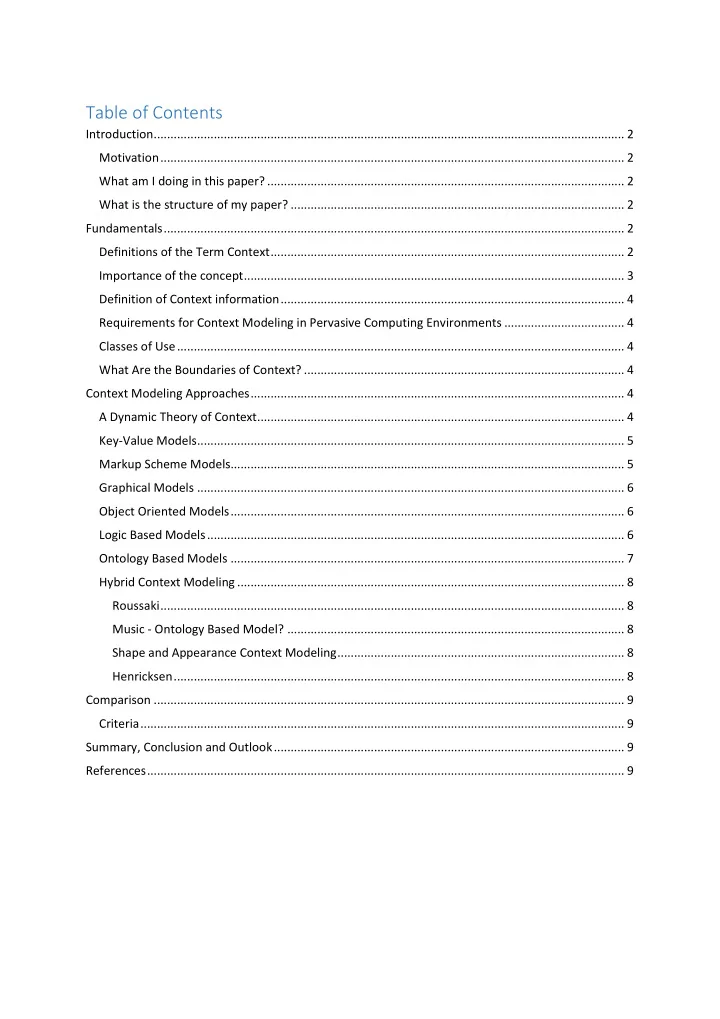

Table of Contents Introduction ............................................................................................................................................. 2 Motivation ........................................................................................................................................... 2 What am I doing in this paper? ........................................................................................................... 2 What is the structure of my paper? .................................................................................................... 2 Fundamentals .......................................................................................................................................... 2 Definitions of the Term Context .......................................................................................................... 2 Importance of the concept .................................................................................................................. 3 Definition of Context information ....................................................................................................... 4 Requirements for Context Modeling in Pervasive Computing Environments .................................... 4 Classes of Use ...................................................................................................................................... 4 What Are the Boundaries of Context? ................................................................................................ 4 Context Modeling Approaches ................................................................................................................ 4 A Dynamic Theory of Context .............................................................................................................. 4 Key-Value Models ................................................................................................................................ 5 Markup Scheme Models...................................................................................................................... 5 Graphical Models ................................................................................................................................ 6 Object Oriented Models ...................................................................................................................... 6 Logic Based Models ............................................................................................................................. 6 Ontology Based Models ...................................................................................................................... 7 Hybrid Context Modeling .................................................................................................................... 8 Roussaki ........................................................................................................................................... 8 Music - Ontology Based Model? ..................................................................................................... 8 Shape and Appearance Context Modeling ...................................................................................... 8 Henricksen ....................................................................................................................................... 8 Comparison ............................................................................................................................................. 9 Criteria ................................................................................................................................................. 9 Summary, Conclusion and Outlook ......................................................................................................... 9 References ............................................................................................................................................... 9
An Overview of Context Modeling Approaches Abstract Context information is the basis for realizing adequate context-aware applications. There are several definitions of context and there are several approaches to model context information. The work should provide an overview of existing modeling approaches and evaluate them with respect to different criteria. TO DO Introduction Motivation Henricksen, K., Indulska, J., & Rakotonirainy, A. (2002). Modeling context information in pervasive computing systems. In Pervasive Computing (pp. 167-180). Springer Berlin Heidelberg. In the past a variety of context models were subject of research, because a well-designed model is a key accessor to the context in any context-aware system. While early models mainly addressed the modeling of context with respect to one application or an application class, generic context models are of interest since many applications can benefit from these. While some models take the users current situation, e.g. “in a meeting” into account, others model the physical envi ronment, i.e. locations. First steps towards a common understanding of context have been published, mostly with respect to location, identity, and time. The objective of most current research is to develop uniform context models, representation and query languages as well as reasoning algorithms that facilitate context sharing and interoperability of applications. 1 What am I doing in this paper? -> Overview of the most relevant current approaches to modeling context What is the structure of my paper? Fundamentals Definitions of the Term Context Many interpretations of the notion of context have emerged in various fields of research like psychology, philosophy, or computer science. Context has often a significant impact on the way humans (or machines) act and on how they interpret things; furthermore, a change in context causes a transformation in the experience that is going to be lived. The word itself, derived from the Latin con (with or together) and texere (to weave), describes a context not just as a profile, but as an 1 Strang/Linhoff-Popien, 2004, S. 1
active process dealing with the way humans weave their experience within their whole environment, to give it meaning. 2 Kokinov, B. (1999). Dynamics and automaticity of context: A cognitive modeling approach. In Modeling and Using Context (pp. 200-213). Springer Berlin Heidelberg. AI and psychological approaches to context are contrasted and the dynamic and automatic nature of the continuous context change in human cognition is emphasized. A dynamic theory of context is presented which defines context as the dynamic state of human mind. It describes the interaction between memory, perception, and reasoning in forming context as well as how they are influenced by context. A general cognitive architecture, DUAL, is presented that implements the mechanisms of context formation and accounts for the context-sensitivity of human cognition. A model of human problem solving, AMBR, has been built upon the DUAL architecture and the simulation experiments performed with it produce data that are coherent with experimental data on human problem solving. SCHILIT, B. N., ADAMS, N. L., AND WANT, R. Context-aware computing applications. In IEEE Workshop on Mobile Computing Systems and Applications (Santa Cruz, CA, US, 1994) SCHILIT, W. N. A System Architecture for Context-Aware Mobile Computing. PhD thesis, Columbia University, 1995. SCHMIDT, A., BEIGL, M., AND GELLERSEN, H.-W. There is more to context than location. Computers and Graphics 23, 6 (1999), 893 – 901. PASCOE, J. Adding Generic Contextual Capabilities to Wearable Computers. In 2nd International Symposium on Wearable Computers (ISWC 1998) (1998), pp. 92 – 99. CHEN, G., AND KOTZ, D. A survey of context-aware mobile computing research. Tech. Rep. TR2000-381, Dartmouth, November 2000. BROWN, P. J., BOVEY, J. D., AND CHEN, X. Context-aware Applications: from the Laboratory to the Marketplace. IEEE Personal Communications 4, 5 (October 1997), 58 – 64. Importance of the concept Ubiquitous computing systems make high demands on any context modeling approach. 1 DETAIL Definition of Ubiquitous computing systems. The concept of context-awareness increasingly gained importance in the area of distributed systems since the 90’s, since it seemed to be a promising solution for a lot of problems which have been implied by the usage of mobile terminals in ever-changing environments. Context dependency is thus a major issue in recent research work in the area of ubiquitous computing systems which are specialisations of mobile, distributed systems. 1 A context model provides an unambiguous definition of the context artifacts, their representations, semantics and usage. It takes into account the general characteristics of context information, such as its temporal nature, ambiguity, impreciseness, incompleteness and privacy. Furthermore, a context model must also address special requirements of pervasive computing environments like distribution, mobility, heterogeneity of context sources and resource-constrained devices. Often, pervasive applications require high-level context information that is derived from low-level context values. Therefore, support for automatic context reasoning has to be provided as well. 3 2 Bolchini, et al., 2007, S.1 3 Reichle, R., Wagner, M., Khan, M. U., Geihs, K., Lorenzo, J., Valla, M., ... & Papadopoulos, G. A. (2008, January). A comprehensive context modeling framework for pervasive computing systems. In Distributed applications and interoperable systems (pp. 281-295). Springer Berlin Heidelberg.
Recommend
More recommend